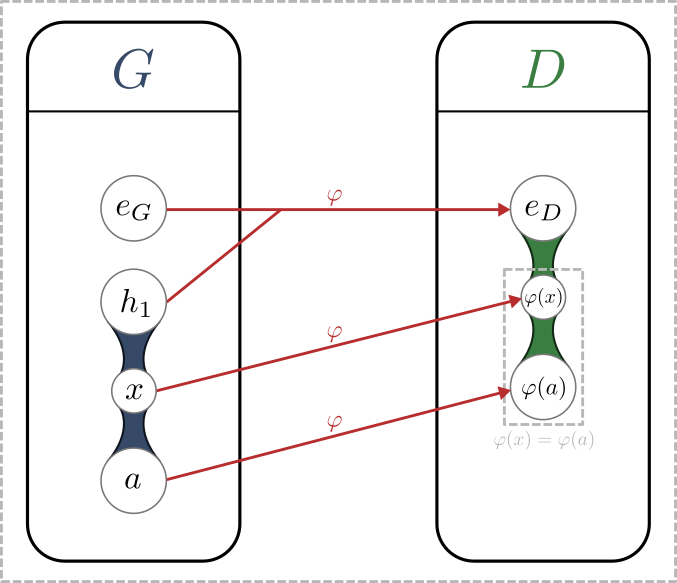Groups. Kernel.
Kernel of a group homomorphism
Let \( \varphi : G \to G' \) be a group homomorphism from group \( G \) to group \( G' \). The kernel of \( \varphi \) is the set of elements of \( G \) that map to \( e_{G'} \) through \( \varphi \).
The kernel of \( \varphi \) is denoted as \( \operatorname{ker} \varphi \).
In other words, \( \varphi \) is the preimage of \( \{ e_{G'} \} \) through \( \varphi \).
From kernel to (equal) cosets
For the below discussion, it's worth remembering that kernels form subgroups, and these subgroups are normal.
Let \( \varphi : G \to D \) be a group homomorphism. Consider the case if \( \operatorname{ker} \varphi \) has 2 elements, \( (e_G, h_1) \). The fact that \( \varphi \) is a group homomorphism introduces some strong requirements on other elements of \( G \). Let \( a \in G \) be an element not in \( \operatorname{ker}(\varphi) \). Then consider:
Note that \( a h_1 = h_1 a \). This commutativity is required so that \( e_D x = x e_D \) in the group \( D \).
In the group \( G \), \( e_G \) and \( h_1 \) are distinct elements, and so \( a \) and \( x \) must also be distinct elements, by the nature of groups. As \( D \) is also a group and \( \varphi \) a group homomorphism, \( a \) and \( x \) must map through \( \varphi \) to the same element in \( D \). This is required to satisfy the requirement of group homomorphisms:
This means that for any \( d \in D \), the preimage of \( d \) through \( \varphi \), \( \operatorname{im} \varphi( \{ d \} \), must have the same number of elements as \( \operatorname{ker} \varphi \)! We can use these preimages to form the blocks in a partition and the resulting equivalence relation is exactly the one corresponding to the quotient \( G \!/ \operatorname{ker}(\varphi) \).
Below is a visualization of this idea.

